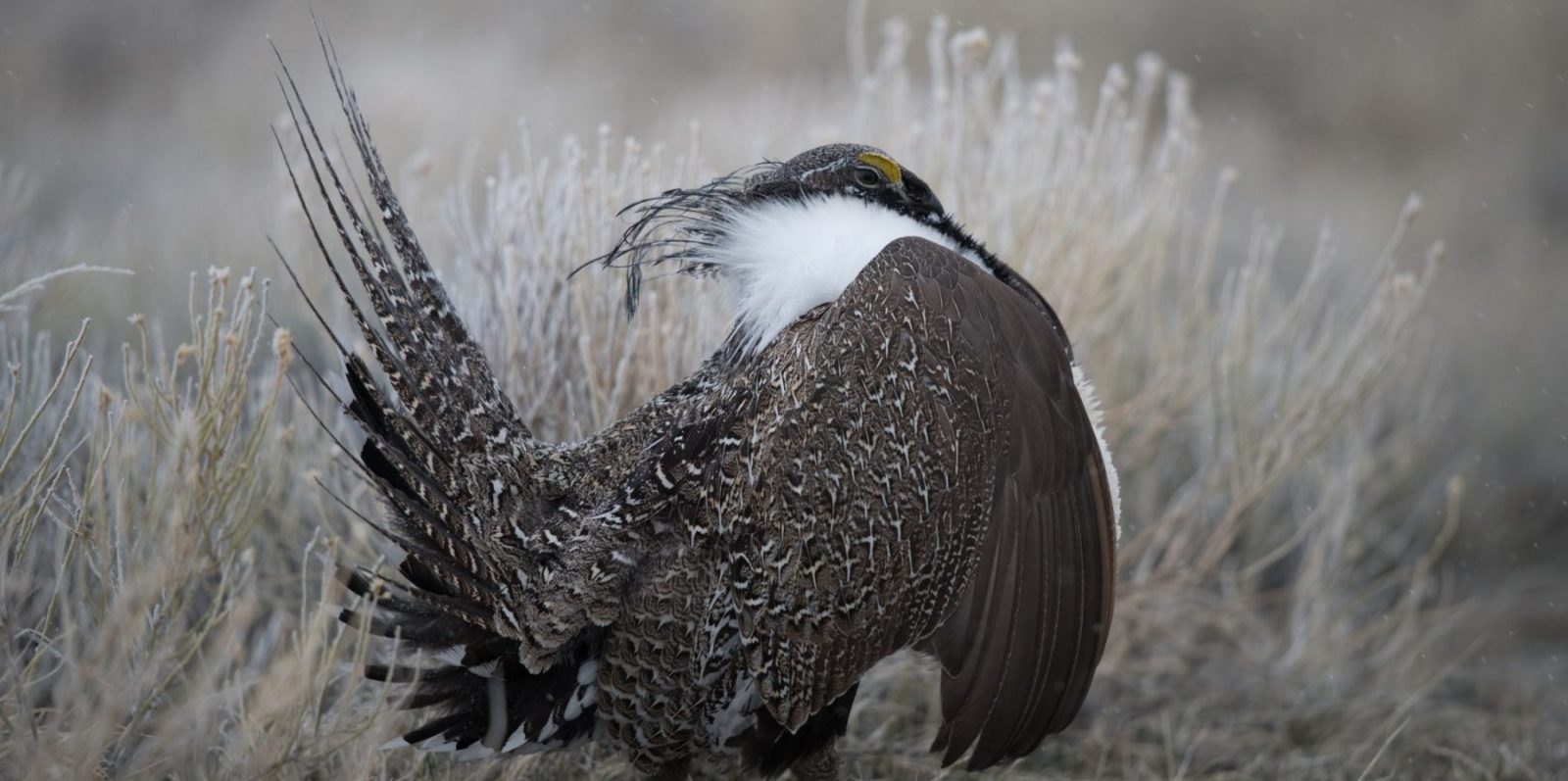[et_pb_section bb_built=”1″ _builder_version=”3.0.47″][et_pb_row _builder_version=”3.0.48″ background_size=”initial” background_position=”top_left” background_repeat=”repeat”][et_pb_column type=”4_4″][et_pb_text _builder_version=”3.17.5″]
Wyoming citizens can tell Interior Secretary Ryan Zinke not to scrap commonsense protections for sage-grouse and the sagebrush ecosystem at two BLM meetings later this month.
The open-house meetings, to be held in Cheyenne and Pinedale, will provide an opportunity for the public to learn more about — and comment on — an ill-conceived BLM proposal that would eliminate habitat protections developed as part of a historic, West-wide conservation plan.
That plan, which Wyoming Governor Matt Mead helped craft and which was approved with broad bipartisan support in 2015, would help maintain healthy sage-grouse populations, as well as vibrant mule deer, elk, and pronghorn herds, and hundreds of other species that rely on intact sagebrush habitat. The plan’s conservation measures are widely credited with keeping the Greater sage-grouse off the endangered species list.
[/et_pb_text][/et_pb_column][/et_pb_row][et_pb_row _builder_version=”3.0.48″ background_size=”initial” background_position=”top_left” background_repeat=”repeat”][et_pb_column type=”1_2″][et_pb_blurb image_max_width=”50%” _builder_version=”3.7″ body_font=”|700|||||||” body_text_align=”center” body_text_color=”#007ea9″ background_color=”#fcaf17″ box_shadow_style=”preset2″ max_width=”85%” custom_margin=”5px|5px|5px|5px” custom_padding=”10px|10px|10px|10px”]
MONDAY,
JUNE 25
4–7 p.m.
Laramie County Library
Cottonwood Meeting Room
2200 Pioneer Ave.
Cheyenne, WY
[/et_pb_blurb][/et_pb_column][et_pb_column type=”1_2″][et_pb_blurb image_max_width=”50%” _builder_version=”3.7″ body_font=”|700|||||||” body_text_align=”center” body_text_color=”#007ea9″ background_color=”#fcaf17″ box_shadow_style=”preset2″ max_width=”85%” custom_margin=”5px|5px|5px|5px” custom_padding=”10px|10px|10px|10px”]
WEDNESDAY, JUNE 27
1:30–4:30 p.m.
Sublette County Library
Lovatt Meeting Room
155 S. Tyler Ave.
Pinedale, WY
[/et_pb_blurb][/et_pb_column][/et_pb_row][et_pb_row _builder_version=”3.0.48″ background_size=”initial” background_position=”top_left” background_repeat=”repeat”][et_pb_column type=”4_4″][et_pb_text _builder_version=”3.17.5″ header_3_font=”|700||on|||||” header_3_text_align=”center” header_3_text_color=”#444444″]
A Collaborative West-wide Conservation Plan
Scrapped in the Name of “Energy Dominance”
Although the Trump administration touts the importance of state engagement and local input, its actions tell a different story.
In what many see as an egregious concession to mining and oil and gas lobbyists, Secretary Zinke last fall ordered his agency to reconsider the historic sage-grouse conservation plans that western stakeholders took years to craft.
These plans, which apply to 11 western states, are a wildly successful example of state engagement and local input. They were endorsed by western governors, conservationists, sportsmen, and many in the agricultural and oil and gas communities. The plans’ protections were modeled after Wyoming’s own strong sage-grouse conservation measures; the best available science, attention to balance development and wildlife management needs, and to keep the Greater sage-grouse from being listed as a threatened or endangered species. The approval of these plans in 2015 was a resounding success story. And Wyoming citizens know it.
Wyoming Citizens Stand Behind the Plans
Last December, Wyoming citizens turned out in force, along with Governor Matt Mead and other state leaders, to demand that the protections for Wyoming’s sage-grouse remain in place. Senator John Barrasso, too, publicly defended Wyoming’s plan.
The Interior Department listened . . . sort of. The BLM has now released draft amendments for each of the 11 states that signed on to the 2015 conservation plan. The amendments to Wyoming’s plan propose keeping some of our good protections. But taken as a whole, the amendments don’t do enough to ensure that sage-grouse populations across the West will be protected.
As Secretary Zinke must understand, keeping the Greater sage-grouse off the endangered species list goes beyond ensuring smart management only in Wyoming. Protecting the species — and its sagebrush habitat — across the west is essential. But the BLM is drastically reducing habitat protections in eight of the 11 states that are part of the West-wide plan, leaving just three — Wyoming, Montana, and Oregon — to carry the weight of protecting this iconic western species. And several changes in the plan proposed for Wyoming will hurt sage-grouse populations right here.
Tell Secretary Zinke: Honor the Deal!
The Department of Interior is currently taking public comment on its draft amendment for Wyoming. If you’re in Pinedale or Cheyenne next week, please attend a BLM open-house meeting to learn more. The BLM is taking public comment on the proposal right now. Come learn more and ask questions at the open houses next week as we prepare to send comments on behalf of our members in August.
Here are a few key points to make in your comments:
- Without reliable, West-wide measures to address ongoing and increasing threats to the Greater sage-grouse and its habitat, we’re likely to find ourselves right back where we started: facing a listing under the Endangered Species Act. That’s not good for the sage-grouse and it’s not good for westerners.
- Wyoming, Montana, and Oregon should not be the only states responsible for range-wide support of the sage-grouse population. The remaining states must help carry the weight. All 11 states that signed on to the 2015 conservation plan must be accountable for their share of the habitat and bird populations.
- The proposal doesn’t do enough in terms of mitigation. The BLM must do everything in its power to improve habitat that has been lost or degraded due to development.
- The proposal provides for more flexibility for “adaptive management.” Although flexibility might make sense, any departures from the original conservation directives must be transparent and backed by the best available science.
Want to know more? Email the Outdoor Council’s Senior Conservation Advocate, Dan Heilig at dan@wyomingoutdoorcouncil.org.
Thanks for standing up for Wyoming!
[/et_pb_text][/et_pb_column][/et_pb_row][/et_pb_section]


